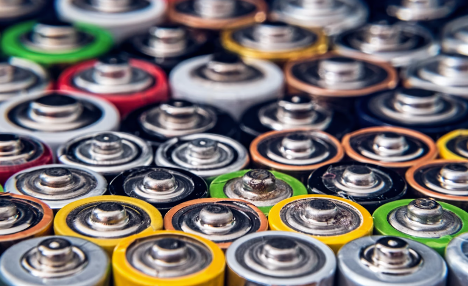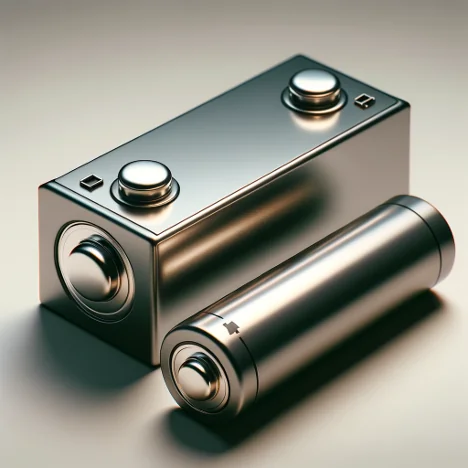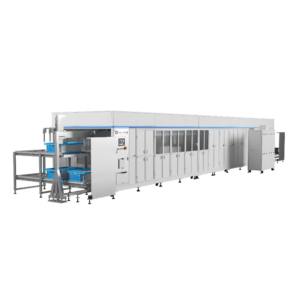On the market, there are two common lithium-ion batteries: cylindrical cells and prismatic cells. Each type has unique characteristics and is used in various applications with different industry requirements for size, shape, energy density, and performance. The following content will help you learn about these when comparing prismatic vs cylindrical cells. Let’s dive in!

Prismatic VS Cylindrical Cells in Appearance
Both cells serve different purposes, so their appearance is also different in shape and size.
Features | Prismatic Cells | Cylindrical Cells |
Shape | Rectangular or square | Always in Cylindrical |
Size | Varied, but always with larger footprints and thinner | Standardized sizes, like 18650 and 21700 |
Construction | Encased in hard or soft shell by plastic or metal | Encased in metal outer layer with safety vent |
Terminals | Flat terminals or tabs on one or both sides | Positive terminal on top, negative terminal on bottom |
Prismatic VS Cylindrical Cell in Performance
1. Density
Both cells have different energy densities. Talking specifically, here are the details on density comparison on prismatic VS cylindrical cells:
Prismatic Cells: Prismatic cells have a larger size, allowing them to contain more energy per cell compared to cylindrical cells. A single prismatic cell can hold the same amount of energy as 20 to 100 cylindrical cells[1]. This higher energy density makes prismatic cells suitable for energy-intensive applications.
Cylindrical Cells: Cylindrical cells are smaller in size compared to prismatic cells. While they may store less energy per cell, they have a higher power output. Cylindrical cells can discharge their energy faster than prismatic cells due to having more connections per amp-hour[1]. This makes cylindrical cells ideal for high-performance applications
2. Longevity
Prismatic Cells: Typically, a prismatic cell can sustain about 2,000 charge-discharge cycles[2] before its capacity begins to significantly degrade. However, the real advantage of prismatic cells becomes apparent when they are assembled into battery packs. In a battery pack configuration, multiple cells are connected together, often with sophisticated management systems that can optimize the performance of each cell and thus extend the overall lifespan of the pack.
Cylindrical Cells: Cylindrical batteries have a longer lifespan, with an average of 25,000 cycles[2]. The longevity is a key reason they are preferred in applications requiring high reliability and extended service life, such as in daily life scenarios, backup systems, and more.
3. Thermal Performance
Prismatic Cells: Prismatic cells have a flat and rectangular shape, which allows for better heat dissipation[3]. However, when prismatic cells are stacked on top of each other, they can overheat faster and easier compared to cylindrical cells.
Cylindrical Cells: Cylindrical cells have a long and round shape, which allows for an even distribution of electrolyte and internal pressure, reducing the likelihood of leaks or cell bloating. The round shape also allows for maximum airflow between each cell, leading to better temperature control and heat dissipation[3].

Prismatic VS Cylindrical Cell in Applications
From the physical and chemistry attributes above, you can grasp some ideas about the application of each type of battery cell. Here’s a chart to make it clearer to comprehend these kinds of cells:
Application | Prismatic Cells | Cylindrical Cells |
Electric Vehicles | Commonly used in cars, buses, and large EVs | Used in some EVs for dense packing, for example, Tesla |
Energy Storage Systems | Large-scale energy storage systems (ESS) for renewable energy integration | Small-scale energy storage, modular battery packs |
Consumer Electronics | Devices where space constraints are critical, such as laptops and high-end smartphones | Power tools, flashlights, portable electronics, smoke alarms, some toys, etc. |
Similarities When Comparing Prismatic VS Cylindrical Cells
Despite structural dissimilarities and different uses, they share the following similarities
- Both have common safety features, such as pressure relief vents, separators to prevent short circuits, and overcharge protection
- Both are rechargeable and cost-effective solutions
- Both are used in electric vehicles and compact electronic devices
- Both share the same environmental concerns
- Both can be manufactured on an automated assembly machine

SZJ Automation’s Prismatic and Cylindrical Cell Turnkey Solution
Above all, when comparing prismatic vs cylindrical cells, different characteristics make them suitable for different applications. When manufacturing them, there should be different production solutions as well. We, SZJ Automation, have 20 years of extensive experience and expertise in the battery manufacturing process. We can provide comprehensive turnkey solutions for both prismatic and cylindrical cells. Here’s how:
1. Cylindrical Cell Turnkey Solution
Our Cylindrical Cell Turnkey Solution is designed to handle production rates of 50 to 350 pieces per minute (PPM), addressing the high-volume needs typical in sectors such as consumer electronics and electric vehicles. Besides, our Research and Development (R&D) team focuses on creating manufacturing equipment that is not only efficient but also flexible and energy-efficient. This tailored approach ensures that each battery produced meets rigorous standards of performance and safety while minimizing environmental impact. Moreover, during the cylindrical cell manufacturing process, our turnkey solution can utilize self-equipped smart technology, like robotic automation, IoT, and machine learning capability. So, our Cylindrical Battery Turnkey Solution is versatile for various production demands. It can provide a one-stop battery manufacturing workshop and ensure optimal operational flow, making the whole process with less waste.
2. Prismatic Cell Turnkey Solution
Our Prismatic Cell Turnkey Solution is engineered to sustain a production throughput of 6 to 20 pieces per minute (PPM), ensuring a balance between high-quality output and efficient production rates suitable for various scenarios, from mobile devices to electric vehicles.
A standout feature of our prismatic battery production line is the integration of our self-developed continuous laser welding technology. This advanced technology significantly amplifies the efficiency of our prismatic and blade cell production equipment. By employing continuous laser welding, our prismatic battery manufacturing solution can achieve a 3 to 5 times increase in efficiency compared to traditional segmental welding methods. This enhancement not only speeds up the manufacturing process but also improves the structural integrity and reliability of the final product.
Conclusion
As two of the vital battery manufacturing types on the market, there are many differences when comparing prismatic VS cylindrical cells, so the similarities are. Their nonidentical appearances, acting and application demonstrate there are different manufacturing processes and production solutions.
And we, SZJ Automation, can provide excellent battery assembly turnkey solutions for prismatic or cylindrical cells. With over 87 invention patents and 93+ software copyrights, we have a robust and innovative R&D team to ensure every machine we manufacture can utilize the latest technology to meet the changeable industrial requirements. Plus, our new factory in Xiangyang, Hubei, China, is equipped with the latest battery testing equipment to ensure the production reliability. If you are interested, please browse SZJ Automation’s website to learn more and contact us!

Reference
- Available at: https://www.laserax.com/blog/prismatic-vs-cylindrical-cells
- Available at: https://www.keyence.com/products/marker/laser-marker/resources/laser-marking-resources/what-is-the-difference-prismatic-cells-vs-cylindrical-cells.jsp
- Available at: https://blog.epectec.com/pros-and-cons-of-lithium-prismatic-cells-vs-cylindrical-cells



